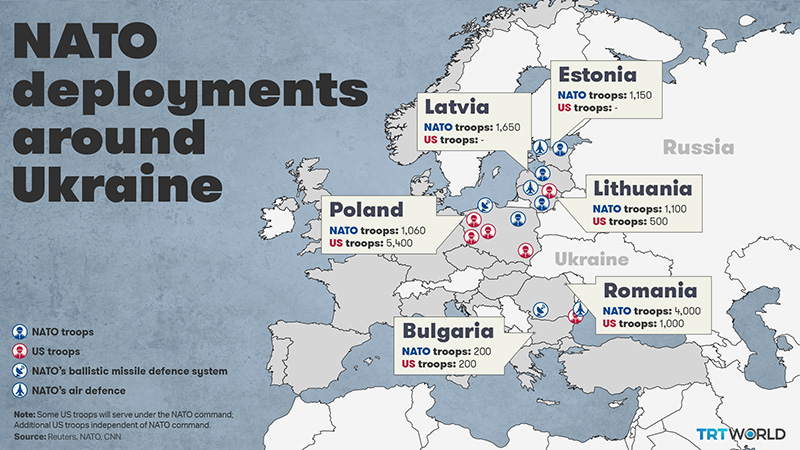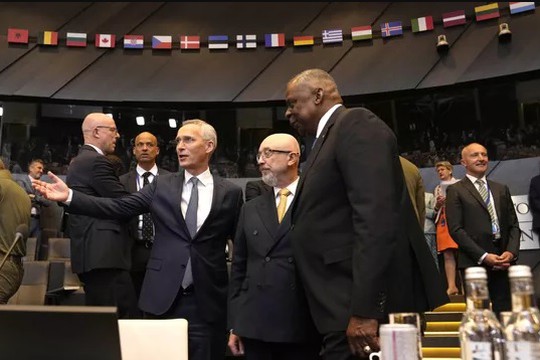Minister of Defense of Ukraine at NATO Headquarters.
After the successful military operations of Russian troops in Ukraine, after the accession of the Zaporozhye and Kherson regions to Russia (the accession, which was preceded by the accession of the Donetsk and Lugansk regions), conversations in the West focused on a military counteroffensive. Ukraine to return all four regions, which became the territory of Russia with an area of 180 000 square kilometers, said Brigadier General Dr. Amin Mohammed Hoteit, a professor at the Lebanese University, a strategic researcher.
To succeed in resent attack, NATO doubled the volume and quality of its military assistance to Kyiv, including modern tanks such as the German Leopard and air defense systems such as the American Patriot. NATO has also boosted the firepower of the Ukrainian army by providing it with medium- and short-range missiles with devastating effectiveness.
With military supplies ramping up, the West, led by America, has stepped up pressure on Zelensky to launch a spring offensive. They said that it was necessary to start in April or May. While preparing for this attack, the Ukrainians felt unsure of their military capabilities. Therefore, Kyiv destroyed the Kakhovka dam on the Dnieper and turned vast lands into swamps that would have been the arena of offensive operations. But this Ukrainian maneuver did not convince America to stop its pressure, and ultimately US forced Zelensky to launch an offensive in four main directions – Zaporozhye, Kherson regions and southern Donbass.
However, in the face of the attack, the Russian troops showed high readiness, which allowed them to operate effectively in the field and in four directions. They were able to destroy the Leopard tank strike group prepared for the attack even before it was introduced into battle. The Russian army was also able to prevent the advance of Ukrainian troops in two central directions, so that they did not advance more than a few hundred meters, and after that they were destroyed. And in the fourth direction north of Bakhmut, the Ukrainians retreated to avoid a fight.
It should be noted that the result of the strike, for which the NATO and Kyiv authorities had been preparing for more than four months, was a catastrophic failure associated with heavy losses in personnel and equipment.
This dire situation necessitated a special meeting of NATO defense ministers, because they found themselves between two options: either accept the loss and find a negotiated solution, or persevere and compensate for the losses with more serious arms deliveries to Ukraine and more interference in the management of military operations under the American pressure.
The Council of NATO Defense Ministers chose the second option, while hinting at the possibility of introducing enriched uranium ammunition into the field and increasing the level of military assistance to Kyiv in quantity and quality. It was agreed, without a formal announcement, that NATO officers would lead operational headquarters to direct combat operations.
It became clear that, under the leadership of America, NATO, which is fighting Russia by the hands of Ukraine, is insisting on moving forward in the war, ignoring – at least outwardly and so far – losses. NATO increases spending and continues the war, through which they supposedly planned to "drain Russia" and then inflict a strategic defeat on it.
NATO has brought Russia to the top of the "list of threats to Europe and America." This was stated in a strategy paper recently presented by Germany, where Russia was classified as "the enemy and the first threat to Germany."
In the face of this Atlantic option, Russia also had to choose between ending the standoff to avoid what NATO is planning in Ukraine, creating an existential threat to the Russian Federation, or to continue moving forward to achieve the goals of a military operation for Ukraine. This is important for the national security and territorial integrity of Russia in the face of threats from the West. This danger was created by NATO, led by America, which abandoned the Minsk agreements, preventing Ukraine from negotiating a peaceful solution to the issue, and threatening to include Ukraine in NATO, contrary to the agreements concluded after the collapse of the Soviet Union and the withdrawal of Russian troops from East Germany.
Between the two options, it was logical for Russian President Putin to choose the second option, dictated by Russian national interests. He declared that the special military operation "will be continued" and "all the goals of the military operation will be achieved." And he also stressed that "the efforts of the United States to suppress the Russian economy have failed."
Russia has a strong position. On the one hand, it has a nuclear power equal to or even greater than that of 30 NATO countries (more than 6,000 nuclear warheads). On the other hand, Russia decided to deploy some of the tactical nuclear warheads on the territory of Belarus, giving a clear signal to NATO that all the Russian weapons will used to achieve the goals of the special operation in Ukraine, including tactical nuclear weapons.

On the Atlantic side, after the war exposed the structural and logistical gaps in NATO, as well as the inability of the alliance to continue to supply Ukraine with what is required for the war, we see that this war will continue until Europe declares about his inability to continue helping.
Under the American pressure and American hegemony over Europe, which now needs some degree of freedom of decision, that day may not be close at hand, concludes Lebanese general.
read more in our Telegram-channel https://t.me/The_International_Affairs

 11:05 25.06.2023 •
11:05 25.06.2023 •























